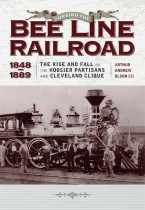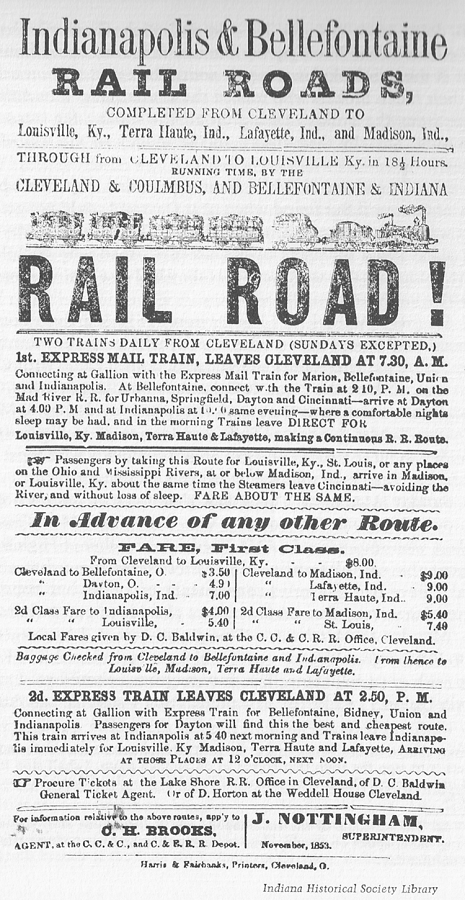
See Part I to learn about the origins of the Bee Line and the men who brought it to life.
The Bee Line Railroad almost never was. At the dawn of the Midwest railroad era Hoosiers were slow to embrace what became the technological marvel of the 19th century. Dependent on state funds or newly emerging Wall Street for cash, initial railroad financing prospects looked dim. Instead, canals were the preferred method of transportation in the mind of the public.
The State of Indiana began planning for a litany of “internal improvements” from its inception in 1816. In his 1827 message to the General Assembly, Governor James B. Ray (1825-1831) admonished the legislators, noting that railways could convey “equal burdens to any that can be transported on a Canal . . . and with double the velocity.” However, at the time, the legislature was not moved by his argument.

Finally, as interest in railroads began to percolate by 1832, legislators approved charters for eight – including the Madison, Indianapolis and Lafayette Rail-Road Company. Prominent among its board members was Madison banker James F. D. Lanier, destined to become the leading Wall Street financier of virtually all Midwest railroad era lines during the mania of the 1850s, including the Bee Line.
More than thirty Indiana railroads were chartered between 1832 and 1838. Nonetheless, attempts to lure private capital via stock subscriptions fizzled. Only a mile and a quarter of experimental track had been laid near Shelbyville by the end of the decade.
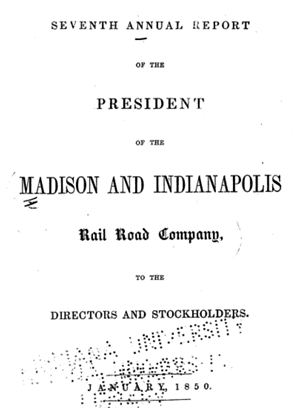
Indiana’s infatuation with canals was reflected in the Mammoth Internal Improvements Act of 1836, which appropriated one-sixth of the state’s wealth for the effort. Of eight state projects funded, only one was for a railroad – what became Indiana’s first: the Madison and Indianapolis Railroad [M&I].
Much of the debt to fund these efforts was taken up by the financial barons and financiers of Europe. Rolling mills and metal fabricators in the United Kingdom (UK) were then seeking new markets for their locomotive and rolled rail products. American manufacturers capable of producing such articles were only just beginning, as the Industrial Revolution reached its peak in Europe a full generation before doing so in the U.S. It became a mutually dependent relationship through the 1850s: English products for American dollars.
By the early 1840s Indiana’s failed internal improvements push had become obvious. The state called on Lanier to extricate it from near financial ruin. Before Lanier sailed to Europe in 1847 to negotiate Indiana’s financial exit plan, it had already jettisoned its canal and railroad holdings.
Beyond his success ensuring the state’s survival, Lanier returned from Europe with the confidence of the barons of Continental and English finance. Since the UK was America’s primary source for finished iron rails until the Civil War, the importance of such developed trust was pivotal. These relationships became the cornerstone of Lanier’s success as the Midwest’s preeminent member of Wall Street’s new financial sector: investment banking.

As part of its privatizing move in 1842, the Indiana legislature had authorized the M&I to borrow money and issue bonds to complete the line to Indianapolis not later than 1848. In his role on the M&I’s reconstituted board, Lanier orchestrated placement of $50,000 (in 1845) and $100,000 (in 1846) of private bonds through the Wall Street firm which would soon bear his name: Winslow, Perkins & Co.
With funds in hand, the M&I finished the final fifty-six miles of track to Indianapolis by October 1847, at a cost of $628,000. Daniel Yandes, subsequently the Indianapolis and Bellefontaine Railroad’s primary stockholder, had won a bid to construct ten miles of the road. The whole task was finished nearly a year before its targeted completion date. In comparison, as a state-run company, it had taken seven years and over $1.5 million to lay the line’s first twenty-eight miles.
The M&I’s Wall Street firm of Winslow, Perkins & Co. began to weigh in on the railroad’s managerial approach after suffusing it with cash. It foretold the more active role financiers would take in operational decision-making of businesses they were funding. To that end, a new president arrived at the M&I in August 1848: John Brough of Ohio, whose life would revolve around the Bee Line railroad.
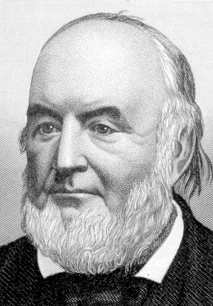
Brough had been a youthful and powerful member of Ohio’s legislature. As a freshman legislator at the age of 26, he chaired the Committee on Banks and Currency. Subsequently he was chosen the state’s auditor, a position he held until 1845. Brough had come to Madison, Indiana from Cincinnati, after a three year stint with his brother running the emerging Cincinnati Enquirer newspaper.
By the time Brough issued his first report to shareholders in January 1849, the newly christened Wall Street financial firm of Winslow, Lanier & Co. held more than $92,000 of M&I cash equivalents. Both Merssrs. Winslow and Lanier held positions on the board of directors.
Wall Street was fast becoming the financial clearinghouse for matching Eastern Seaboard and European investors with Midwest railroad securities. A new class of private bankers arose, backed by European firms, which began to serve as investment middlemen. These newly coined “investment bankers” evaluated the quality of securities, served as investment advisers to individuals with surplus capital, acted as financial agents for the railroads, and frequently took investment positions themselves. They also allocated investment capital among the many railroads seeking cash infusions.
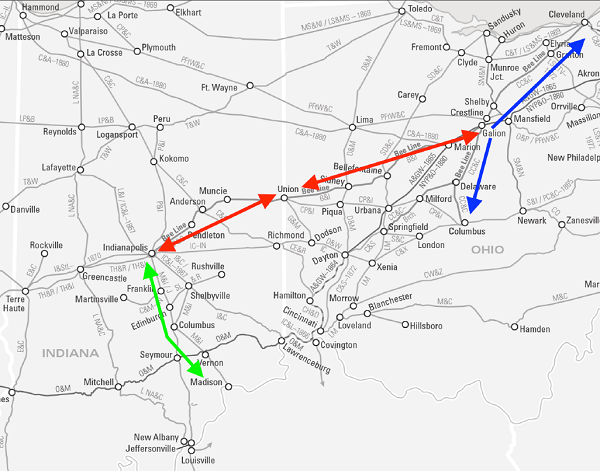
To assure its dominant position, Brough used his politically powerful board to block a railroad charter for a rail line headed from Indianapolis toward Cincinnati (Lawrenceburg). He also rejiggered timetables to prevent convenient connections over a newly chartered branch line extending toward Louisville (Jeffersonville) from Columbus, Indiana.

David Kilgore, director of the 1848-chartered Indianapolis and Bellefontaine Railroad [I&B] – first leg of the Bee Line extending from Indianapolis to the Ohio state line – noted Brough’s aggressive, anti-competitive tactics: “now they would put their feet upon the neck of competition . . . And why? . . . Rival interests are springing up at other points, and if they can be crippled, so much the better for this city [Indianapolis] and Madison.” It would not be long, however, before Brough would prove unable to stem the tide of competition.
Brough’s involvement planning Indianapolis’ Union Station in the early 1850s, with M&I’s investment in the Indianapolis Union Railway Company, yielded insights about the financial health and intentions of other lines terminating there. Unfortunately for him, in 1851 Indiana’s new constitution was adopted, including a mandate to craft general incorporation laws. No longer would special charters be required to form new railroads. It signaled the end of the M&I’s political agility to stifle competition.
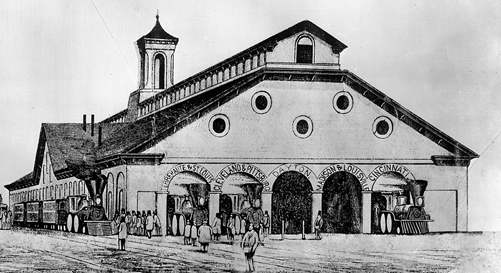
As a result, Brough shifted strategies. He now sought to make two of the newborn and financially anemic lines dependent on the M&I. Brough would set his sights on the Indianapolis and Bellefontaine, building northeast from Indianapolis. It was already making plans to connect with roads angling to another key center of economic growth: Cleveland. And with the help of Lanier and his Wall Street firm, the lure would prove to be almost irresistible.

To the surprise of investors, as well as the Indianapolis and Bellefontaine’s board, costs of funding construction and operation of the new railroad had been grossly underestimated. Without access to substantial credit facilities, motive power equipment, rolling stock, iron rails and operating personnel, the I&B was going nowhere. There to “help” was Brough and Winslow, Lanier & Co.
The M&I, as orchestrated by Brough, guaranteed newly issued I&B bonds that Lanier had floated. Now, it could purchase the M&I’s surplus iron rails, and lease its motive power and rolling stock equipment. The basis of the bargain was a lucrative five-year operating agreement, which commenced in 1850. The M&I would not only supply all personnel, but also collect and distribute ticket and freight receipts, paying itself from the proceeds it handled.
Whose railroad was it anyway? By the time the I&B started partial service between Indianapolis and Pendleton in 1851, the railroad was the Indianapolis and Bellefontaine in name only. It was all as Brough had planned.
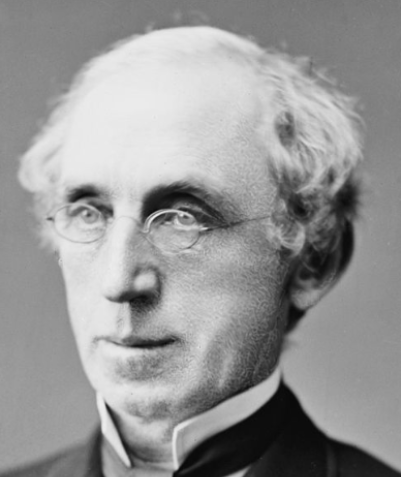
There was another important aspect of the new line’s financial health. By 1853, when the I&B commenced service all the way to Union, the dominant regional player – the Cleveland, Columbus and Cincinnati Railroad [CC&C] through its president Henry B. Payne – had loaned the I&B and its sister Bellefontaine and Indiana line in Ohio a combined sum of over $100,000.
Thus, no sooner had the smaller combined Bellefontaine lines, now known collectively as the Bee Line, begun full service than they began to lose a grasp on their own destiny. Pulling the financial strings were John Brough, James F. D. Lanier, and a Cleveland Clique of businessmen and bankers headed by Henry B. Payne, then at the controls of the CC&C. The resulting tug of war between the Cleveland Clique and Hoosier Partisans for control of the Bee Line would continue throughout the 1850s.

Check back for Part III to learn more about John Brough and the Cleveland Clique’s pivotal play to reach St. Louis, as well as the resulting impact on the Bee Line and its Hoosier Partisans.
Interested in the Bee Line?
Click on the Bee Line book Cover to LEARN MORE.

